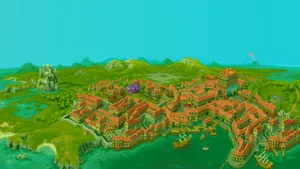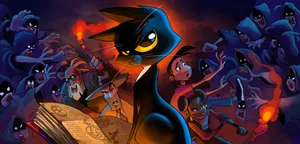Board Game Review: Machi Koro
July 11, 2015
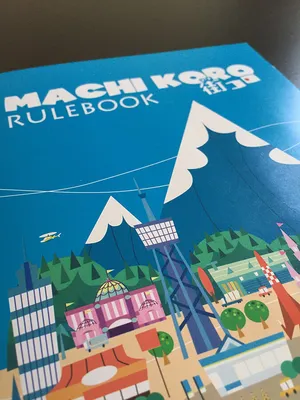
I recently bought a few more board games and Machi Koro is one of them. Well, actually it's a card game. One of the reasons I bought it was because of the very nice design.
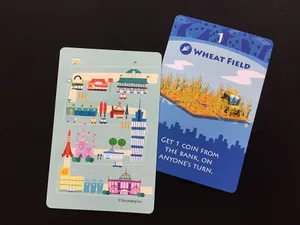
Machi Koro is a city building game that can be played from two to four players. The goal of Machi Koro is to be the first in finishing the four big landmarks.
Inventory:
- 2 dice (one green and one blue)
- 16 Landmark start cards (Train station, Shopping mall, Amusement park, Radio tower)
- 8 Establishment start cards (Wheat field and bakery)
- 72 Estabishment cards (Blue, green and red fronts)
- 12 Major Establishment cards (purple front)
- 78 Coins (values 1, 5 and 10)
Preparations before playing:
Every player should get two different establishment start cards, four different landmark start cards and three coins with a value of one.
Put all the cards in front of you and make sure you turn the four landmark cards with the construction side faced up (grey side).
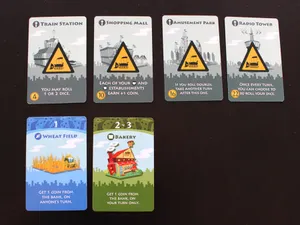
The rest of the establishment cards should be placed in small stacks that group them by type. And those stacks should be ordered in rows of five, according to their required dice roll. Further in the game this is called the marketplace.
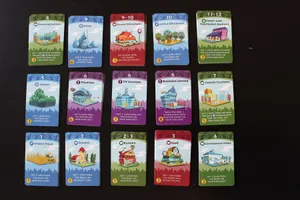
Building types
Let's start by explaining the basic establishment cards.
Almost all establishment cards contain the following information:
- The dice roll that's needed
- The type and name
- The effect of the building
- The construction cost
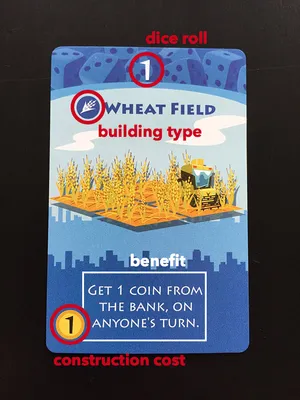
The four landmarks only contain these:
- The type and name
- The effect of the building
- The construction cost
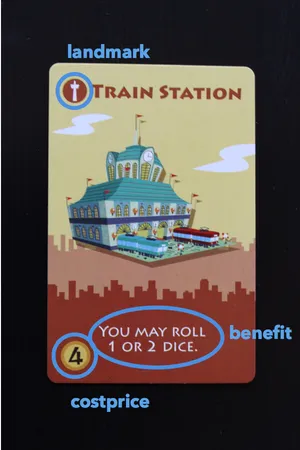
As you probably noticed by now, every building has it's own advantage into helping you progress in the game.
The type of advantage is easily recognizable through the colour of the card.
- A blue establisment will always be one that everyone can obtain, whoever throws the dice.
- A green establishment is one you can ony benefit from when you yourself throw the required number on the card.
- A red establishment is one where you benefit from when someone else throws the dice.
- A purple establishment is one you can only benefit one when you yourself throw a six. These are special establishments (landmarks) and only one of each can be build.
So now we can start playing the game.
Let's start playing
There are two dice in the game but every player starts with one. Which makes total sense since the two establisments that you start with have a dice roll of one, two and three.
Each player's turn consists of the following actions:
- Roll the dice (one or two)
- Collect income
- Construct another establisment
A first round
The first player starts with his turn by rolling one dice. If it's a one, a two or a three the player or players collect their income.
After this he can choose to build one of the four big landmarks (but only one is financially possible at this point) Or they can build one of the establishments from the market place. This is purely up to the current player.
Sounds easy right? Well it actually is that easy :)
Earn income
Players earn their income from their buildings by dice rolls. Under building types I described the different colors of the building cards: blue, green, red and purple.

Let's refresh
You will always benefit from blue type buildings no matter who rolled the dice. As long as the dice roll matches the number on the card.
A green type building only earns you income when you're the dice roller and have matched the dice roll on the card.
A red type building earns you income when someone else matches the dice roll. But only the one that rolled the dice has to pay.
And last but not least. The purple type buildings earn you income whenever you roll a six. Other players will have to pay you according to the rules on the card.
So think wisely before you build certain types of buildings!
Building
Since our income depends on it let's dive a little deeper into building.
A player can only build a single building during his turn and he must choose between a landmark or an establishment. Like I mentioned before, you can build as many establishments as you want. Except for landmarks, you can only build one of each when it comes to those. This also includes the purple cards in the marketplace.

So if the player chooses a landmark, he must turn around the landmark card with the colored side up.
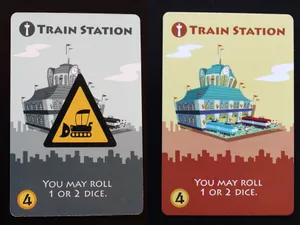
This unlocks the advantage that this card offers. For example the trainstation allows you to throw with two dice instead of one. You can still opt to throw just one dice. But now you have the choice, every time it's your turn.
Further in the game
At some point when someone rolls a three for example and one or a few people have build a red establisment (a café). The player that rolled the dice will have to pay each person with a café.
This also means that if a person has multiple cafés, the effect will be multiplied with the amount he owns.
When the dice thrower has to pay multiple people, normally the rules are that the dice thrower has to pay them what he can, starting with the 1st person going counterclockwise. And the idea is that you pay them one by one until everything is paid or the dice thrower's out of money.
Personally I prefer to apply the rule that every debt collecter get's the same amount if possible. Or that you throw dice to see who get's to collect the debt.
The end
When a player has finished building all four of the special landmark cards, the game ends. It doesn't matter how many buildings you have in total. The winner is determined by finishing first.
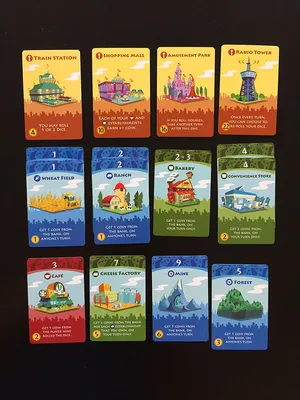
My conclussion
Machi Koro is a luck-based cardgame, suitable for two to four players. It has very nice graphics and is easy to play. But I am not sure if it can keep advanced players interested. Game duration is about 30 minutes, however it depends on the amount of players and luck.
Currently there are two expansions available for Machi Koro:
- harbor
- millionaire's row
I decided to buy the English version of Machi Koro and paid 9 euros more than for the Dutch version. The Dutch version only costs 14 euros. The price difference is a bit unfortunate. I like games that aren't language dependable. And that's always a downside for card games.
In one sentence:
I think Machi Koro is a great introduction game or if you don't have much time to play.

